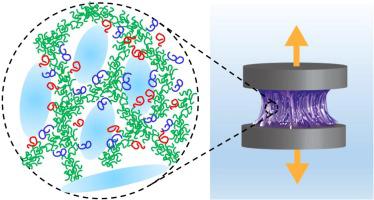当前位置:
X-MOL 学术
›
Eur. Polym. J.
›
论文详情
Our official English website, www.x-mol.net, welcomes your feedback! (Note: you will need to create a separate account there.)
Temperature-Responsive Polyelectrolyte Complexes for Bio-Inspired Underwater Adhesives
European Polymer Journal ( IF 6 ) Pub Date : 2020-12-01 , DOI: 10.1016/j.eurpolymj.2020.110034 Ilse A. van Hees , Anton H. Hofman , Marco Dompé , Jasper der Gucht , Marleen Kamperman
European Polymer Journal ( IF 6 ) Pub Date : 2020-12-01 , DOI: 10.1016/j.eurpolymj.2020.110034 Ilse A. van Hees , Anton H. Hofman , Marco Dompé , Jasper der Gucht , Marleen Kamperman

|
Abstract Adhesive proteins of marine organisms contain significant amounts of hydrophobic amino acids. Therefore, inter- and intramolecular hydrophobic interactions are expected to play an important role in both adhesion and cohesion. Here, we mimic the hydrophobicity of adhesive proteins by using temperature-responsive polyelectrolyte complexes (TERPOCs) with a high poly(N-isopropylacrylamide) (PNIPAM) content. Upon mixing aqueous solutions of PNIPAM-b-poly(acrylic acid)-b-PNIPAM and poly(2-(dimethylamino) ethyl methacrylate) (PDMAEMA), complexation between the oppositely charged polyelectrolytes occurs. At low temperatures, complex coacervate core micelles (C3Ms) with a PNIPAM corona are formed, and upon a temperature increase, the solution turns into a hydrogel by the formation of a network of hydrophobic PNIPAM domains. Consequently, an abrupt increase in viscosity is observed upon heating which facilitates injectability of the adhesive. The gelation temperature, Tgel, and (adhesive) strength of the TERPOC can be adjusted by altering the salt and polymer concentration, which changes the balance between the electrostatic and hydrophobic interactions. Despite the importance of hydrophobic groups in strong underwater adhesives, we conclude that TERPOCs with a high PNIPAM content (70 wt%) are unstable due to water release. Consequently, there is a limited amount of hydrophobic groups that can be inserted in this type of systems. Nevertheless, TERPOCs show promising and tunable properties for application as injectable underwater adhesives, for example in biomedical applications.
中文翻译:

用于仿生水下粘合剂的温度响应聚电解质复合物
摘要 海洋生物的粘附蛋白含有大量疏水性氨基酸。因此,分子间和分子内疏水相互作用有望在粘附和内聚力中发挥重要作用。在这里,我们通过使用具有高聚(N-异丙基丙烯酰胺)(PNIPAM)含量的温度响应性聚电解质复合物(TERPOC)来模拟粘附蛋白的疏水性。在混合 PNIPAM-b-聚(丙烯酸)-b-PNIPAM 和聚(2-(二甲氨基)甲基丙烯酸乙酯)(PDMAEMA)的水溶液后,带相反电荷的聚电解质之间会发生络合。在低温下,形成具有 PNIPAM 电晕的复合凝聚核胶束 (C3Ms),当温度升高时,溶液通过形成疏水性 PNIPAM 结构域网络而变成水凝胶。最后,在加热时观察到粘度突然增加,这促进了粘合剂的可注射性。TERPOC 的胶凝温度、Tgel 和(粘合)强度可以通过改变盐和聚合物浓度来调整,这会改变静电和疏水相互作用之间的平衡。尽管疏水基团在强水下粘合剂中很重要,但我们得出结论,具有高 PNIPAM 含量 (70 wt%) 的 TERPOC 由于水释放而不稳定。因此,可插入此类系统中的疏水基团数量有限。尽管如此,TERPOCs 显示出作为可注射水下粘合剂应用的有前途和可调的特性,例如在生物医学应用中。TERPOC 的胶凝温度、Tgel 和(粘合)强度可以通过改变盐和聚合物浓度来调整,这会改变静电和疏水相互作用之间的平衡。尽管疏水基团在强水下粘合剂中很重要,但我们得出结论,具有高 PNIPAM 含量 (70 wt%) 的 TERPOC 由于水释放而不稳定。因此,可插入此类系统中的疏水基团数量有限。尽管如此,TERPOCs 显示出作为可注射水下粘合剂应用的有前途和可调节的特性,例如在生物医学应用中。TERPOC 的胶凝温度、Tgel 和(粘合)强度可以通过改变盐和聚合物浓度来调整,这会改变静电和疏水相互作用之间的平衡。尽管疏水基团在强水下粘合剂中很重要,但我们得出结论,具有高 PNIPAM 含量 (70 wt%) 的 TERPOC 由于水释放而不稳定。因此,可插入此类系统中的疏水基团数量有限。尽管如此,TERPOCs 显示出作为可注射水下粘合剂应用的有前途和可调的特性,例如在生物医学应用中。尽管疏水基团在强水下粘合剂中很重要,但我们得出结论,具有高 PNIPAM 含量 (70 wt%) 的 TERPOC 由于水释放而不稳定。因此,可插入此类系统中的疏水基团数量有限。尽管如此,TERPOCs 显示出作为可注射水下粘合剂应用的有前途和可调的特性,例如在生物医学应用中。尽管疏水基团在强水下粘合剂中很重要,但我们得出结论,具有高 PNIPAM 含量 (70 wt%) 的 TERPOC 由于水释放而不稳定。因此,可插入此类系统中的疏水基团数量有限。尽管如此,TERPOCs 显示出作为可注射水下粘合剂应用的有前途和可调的特性,例如在生物医学应用中。
更新日期:2020-12-01
中文翻译:

用于仿生水下粘合剂的温度响应聚电解质复合物
摘要 海洋生物的粘附蛋白含有大量疏水性氨基酸。因此,分子间和分子内疏水相互作用有望在粘附和内聚力中发挥重要作用。在这里,我们通过使用具有高聚(N-异丙基丙烯酰胺)(PNIPAM)含量的温度响应性聚电解质复合物(TERPOC)来模拟粘附蛋白的疏水性。在混合 PNIPAM-b-聚(丙烯酸)-b-PNIPAM 和聚(2-(二甲氨基)甲基丙烯酸乙酯)(PDMAEMA)的水溶液后,带相反电荷的聚电解质之间会发生络合。在低温下,形成具有 PNIPAM 电晕的复合凝聚核胶束 (C3Ms),当温度升高时,溶液通过形成疏水性 PNIPAM 结构域网络而变成水凝胶。最后,在加热时观察到粘度突然增加,这促进了粘合剂的可注射性。TERPOC 的胶凝温度、Tgel 和(粘合)强度可以通过改变盐和聚合物浓度来调整,这会改变静电和疏水相互作用之间的平衡。尽管疏水基团在强水下粘合剂中很重要,但我们得出结论,具有高 PNIPAM 含量 (70 wt%) 的 TERPOC 由于水释放而不稳定。因此,可插入此类系统中的疏水基团数量有限。尽管如此,TERPOCs 显示出作为可注射水下粘合剂应用的有前途和可调的特性,例如在生物医学应用中。TERPOC 的胶凝温度、Tgel 和(粘合)强度可以通过改变盐和聚合物浓度来调整,这会改变静电和疏水相互作用之间的平衡。尽管疏水基团在强水下粘合剂中很重要,但我们得出结论,具有高 PNIPAM 含量 (70 wt%) 的 TERPOC 由于水释放而不稳定。因此,可插入此类系统中的疏水基团数量有限。尽管如此,TERPOCs 显示出作为可注射水下粘合剂应用的有前途和可调节的特性,例如在生物医学应用中。TERPOC 的胶凝温度、Tgel 和(粘合)强度可以通过改变盐和聚合物浓度来调整,这会改变静电和疏水相互作用之间的平衡。尽管疏水基团在强水下粘合剂中很重要,但我们得出结论,具有高 PNIPAM 含量 (70 wt%) 的 TERPOC 由于水释放而不稳定。因此,可插入此类系统中的疏水基团数量有限。尽管如此,TERPOCs 显示出作为可注射水下粘合剂应用的有前途和可调的特性,例如在生物医学应用中。尽管疏水基团在强水下粘合剂中很重要,但我们得出结论,具有高 PNIPAM 含量 (70 wt%) 的 TERPOC 由于水释放而不稳定。因此,可插入此类系统中的疏水基团数量有限。尽管如此,TERPOCs 显示出作为可注射水下粘合剂应用的有前途和可调的特性,例如在生物医学应用中。尽管疏水基团在强水下粘合剂中很重要,但我们得出结论,具有高 PNIPAM 含量 (70 wt%) 的 TERPOC 由于水释放而不稳定。因此,可插入此类系统中的疏水基团数量有限。尽管如此,TERPOCs 显示出作为可注射水下粘合剂应用的有前途和可调的特性,例如在生物医学应用中。



























 京公网安备 11010802027423号
京公网安备 11010802027423号